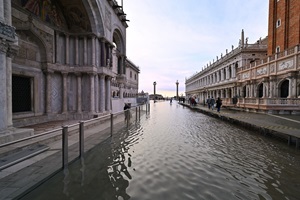An extraordinary engineering system comprising extra clear glass and steel is now in operation to protect Italy’s Basilica of San Marco in Venice from high tides.
Located in the lowest area of Venice, the Piazza San Marco, one of the most famous monumental squares in Italy, is known worldwide for its unique beauty. However, with the average high water in the city regularly exceeding 60 cm, the Cathedral runs the daily risk of being damaged by high tides. The Basilica’s pavement and antechamber (Narthex) in front of the main entrance have become submerged no less than 250 times in recent years.
The Basilica’s architectural solution
To keep the cathedral safe from damage, an architectural solution, using Pilkington glass, has been installed to provide enhanced protection to one that already exists – the MOSE, a system of mobile barriers designed to reduce the entry of the tides from the harbour inlets. Currently, it is of just partial use since it is activated only when the rise of tide exceeds 110 cm.
A grander overall, long-term solution is under construction – that of providing a more efficient seal from rising groundwater and sewage as well as raising the entire St. Mark's Pier Insula (built area) to facilitate better rainwater run-off. In the meantime, the steel and Pilkington Glass watertight barrier, will not only help protect the structure from erosion, but thanks to the choice of material, also provides unobstructed views over the square and Cathedral.
Widely used in architecture for interior and exterior design, Pilkington Optiwhite™ extra-clear glass was the perfect choice for this prestigious project that not only demanded the highest quality of protection, but also superior elegance. Its low-iron content allows the true colour of the marble to be appreciated through the thickness of the glass barrier, which is laminated with a rigid interlayer. The resulting three-ply glazed panel is suitable for use in humid environments and capable of improving not only the mechanical characteristics, but also the post-breakage behaviour of the glazed panels.
 The structure includes modules comprising steel uprights holding the panels that are securely fixed to the concrete base slabs. The finished project has been load-tested to extremes so that even in the unlikely event of a breakage of one of the plies, the whole structure will remain intact and continue to protect the Cathedral.
The structure includes modules comprising steel uprights holding the panels that are securely fixed to the concrete base slabs. The finished project has been load-tested to extremes so that even in the unlikely event of a breakage of one of the plies, the whole structure will remain intact and continue to protect the Cathedral.
Zanatta Vetro, spokesman for Montebelluna (TV), the company that assembled the glazed section, explained the composition:
“Comprising three laminated glass plies, the 12 mm-thick central ply is inserted between two 10 mm-thick plies – all are connected using rigid interlayers. The panes are toughened, and heat-soak tested. These processes were able to triple the bending strength of glass and help avoid spontaneous breakage caused by potential nickel sulphide inclusions.”
Matteo Grappiglia, Director of GR Strutture of Vigodarzere (PD), the company that carried out this project, clarifies some details on its complexity:
"On receipt of the order in March, the project was subjected to detailed engineering and design work, that included preparatory processes for the production of metal components in the workshop, culminating in sealing the glass and steel modules – the heaviest one weighing close to 1,800 kg.
Despite the complexities, we were able to ensure that the two-month installation period was completed in time to preserve the narthex from the first high tide of the season on 7 November. Inauguration took place 12 days later in the presence of the highest state and regional officers. Ongoing access via six watertight gates, including horizontal modules, ensures the site remains open for visitors.
“By using this glass as the main material for this architectural project, its extraordinary mechanical and filter characteristics allow it to leave the water outside while preserving the integrity of what is enclosed.”
Photography: Pierpaolo Campostrini